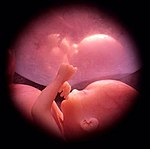Progesteron


Progesteron, eller gulkroppshormon, är ett steroidhormon med många viktiga funktioner för båda könen. Dels fungerar det som förstadium till andra könshormoner såsom testosteron och östrogen samt kortikosteroider, och dels verkar det i sig självt. Som hormon är det främst känt som ett kvinnligt könshormon med betydelse för kvinnans sekundära könskarakteristika, fertilitet och för embryogenesen, men det har också en viktig roll som neurosteroid i centrala nervsystemet.
Progesteron bildas av kolesterol via pregnenolon i gulkroppen, binjurar, placenta och gliaceller i hjärnan. Det kan sedan ombildas till mineralkortikoider, glukokortikoider, DHEA, androgener och östrogener, vilka inte kan bildas utan att kolesterolet omvandlats till denna fas - eller verka i sig själv som hormon. Det binds till sina målceller av steroidreceptorer av klassen progesteronreceptorer, vilka är kärnreceptorer, men progesteron kan verka i flera andra receptorer och modifiera aktiviteten på andra hormoner.
Som hormon verkar progesteron på livmodern, kvinnobrösten, och i hjärnan. I hjärnan är progesteronet ett neurohormon som har stark påverkan på centrala nervsystemet och dess signalsubstanser och neuropeptider. Dess påverkan sker genom att det i cellkärnorna påverkar nervcellerna till att verka mera långvarigt och långsamt samt modifierar proteinsyntesen där. Det påverkar också både bildningen av signalsubstanserna och frisättningen av dem. Förändrade värden progesteron påverkar därför centrala funktioner i medvetandet, kognitionen och sinnesstämningen. Djurförsök har visat att det påverkar stressaxeln. I limbiska systemet påverkar det bland annat serotoninets aktivitet, genom att under stress förändra serotoninreceptorernas metabolism. Det har vidare en stor inverkan på katekolaminerna och GABA.[1]
Som kvinnligt könshormon förbereder det graviditet, håller fostret vid liv samt förhindrar ägglossning. Nivåerna för en icke-gravid, fertil kvinna når därför en topp som börjar några dagar efter ägglossning och avtar någon dag innan menstruationen börjar.
Andra former av progestagener används som preventivmedel.
Källor
- ^ A.R.Genazzani et al, Progesterone, progestagens and the central nervous system, Human Reproduction, Vol. 15, (Suppl. 1), pp. 14-27, 2000
| ||||||||||||||||||||||||||||||
| |||||||||||||||||||||||||||||||||
| |||||||||||||||||||||||||||||
Media som används på denna webbplats
Författare/Upphovsman: Ivon19, Licens: CC BY-SA 4.0
una de las imagenes mas hermosas de la vida del ser humano
Reference ranges for the blood content of progesterone (LH) during the menstrual cycle.
Interpretation
The time scale starts with the beginning (or "onset") of (last) menstrual period (LMP), given as day number. Day number 1 corresponds to 0 to 0.99 days from LMP, and Day number 2 corresponds to 1.00 to 1.99 days from LMP and so forth. The time scale ends at whatever is the actual next menstruation, which marks the beginning of the next cycle, which is equivalent to starting all over again from the beginning of the time scale.
- Inter-cycle (also called within-woman or intrawoman) variability for ovulation and next menstruation are the 95% prediction intervals for the timing of these events in any single woman, assuming an inter-cycle average duration that is equal to population average.
- Inter-woman variability for ovulation and next menstruation are the 95% prediction intervals for the timing of these events in the overall population.
Hormone levels represent usual ones, not necessarily related to what is healthy. Hormone ranges vary between cases at the same biological stage of the menstrual cycle. Furthermore, the actual timing (usually given in day numbers from mentruation) of that biological stage varies, both between cycles of any single woman (inter-cycle) and between somen (inter-woman). Therefore, the appropriate ranges to use depend on how certain the actual biological stage can be estimated at any time.
- The ranges denoted By biological stage are the 90% prediction intervals for hormone levels for women at the same biological stage. These reference ranges may be used in closely monitored menstrual cycles in regard to other markers of its biological progression, with the time scale being compressed or stretched to how much faster or slower, respectively, the cycle progresses compared to an average cycle. In the luteal phase, a known time of ovulation is sufficient to use these ranges.
- The ranges denoted Inter-cycle variability (also called within-woman or intrawoman variability) are the up to 95% prediction intervals for any single woman, assuming an inter-cycle average duration that is equal to population average. These ranges are more appropriate to use in non-monitored cycles with only the beginning of menstruation known, but where the woman accurately knowing her average cycle lengths and time of ovulation, and that they are somewhat averagely regular, with the time scale being compressed or stretched to how much a woman's average cycle length is shorter or longer, respectively, than the average of the population.
- The ranges denoted Inter-woman variability are the up to 95% prediction intervals for hormone levels in the overall population. These ranges are more appropriate in non-monitored cycles, where the average cycle lengths and time of ovulation are unknown, but only the beginning of menstruation is given.
Derivation
See source article:
- (2014). "Reference ranges for estradiol, progesterone, luteinizing hormone and follicle-stimulating hormone during the menstrual cycle". WikiJournal of Medicine 1 (1). DOI:10.15347/wjm/2014.001.



